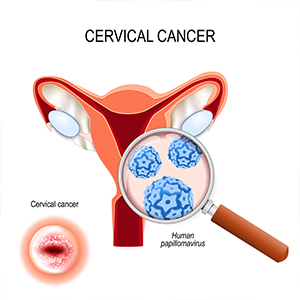Cervix Cancer Screening in Hyderabad
Cervical cancer is a growth of cells that begins within the cervix. The cervix is the lower portion of the uterus that connects to the vagina, becoming precancerous. While not all precancerous cells progress to cancer, detecting and treating these abnormal cells before they transform is vital for preventing cervical cancer. It typically progresses slowly. Before the onset of cancer, the cervical cells undergo dysplasia, during which these cells emerge in the cervical tissue. If left untreated, these abnormal cells may evolve into cancerous cells, spreading deep into the cervix and adjacent regions.
There are the main types in the cervix, they are; Ectocervix (also known as exocervix): This is the outer portion of the cervix visible during gynecological exams. Endocervix: This inner part of the cervix forms a canal connecting the vagina to the uterus. A column-shaped glandular cells that produce mucus. The squamocolumnar junction, also called the transformation zone, is where the endocervix and ectocervix meet. This area is where most cervical cancers originate.
Cervical cancers are categorized based on the type of cell they originate from. The main types are:

- Squamous cell carcinoma: This type, accounting for up to 90% of cases, starts from cells in the ectocervix.
- Adenocarcinoma: These cancers develop in the glandular cells of the endocervix. Clear cell adenocarcinoma is a rare subtype of cervical adenocarcinoma.
In very rare instances, cancer can develop in other cervix cells.
Symptoms of cervical cancer can include:
- Watery or bloody vaginal discharge, potentially heavy and with a bad smell.
- Painful sex, vaginal bleeding during sex, bleeding between menstrual periods, or post-menopause.
- Menstrual periods may become heavier and longer than usual.
- Difficult or painful urination, possibly with blood in urine.
- Diarrhea or rectal pain or bleeding during bowel movements, constipation.
- You might experience, tiredness, weight loss, and loss of appetite.
- Dizziness or feelings of illness.
- Severe back pain or leg swelling.
- Sharp and severe pelvic or abdominal pain.
Causes for the cervix cancer
Cervical cancer begins with changes in the DNA of healthy cells in the cervix. DNA acts as the cell's instruction manual, directing its activities. These changes prompt the cells to multiply rapidly and persist when they should naturally die off. This abnormal growth leads to the formation of too many cells, potentially forming a tumor. These cells can invade and damage surrounding healthy tissue. Over time, they may break away and spread to other parts of the body.
The primary cause of most cervical cancers is the human papillomavirus (HPV), a common virus transmitted through sexual contact. While HPV typically clears up on its own without causing issues for most people, in some cases, it can trigger changes in cervical cells that increase the risk of cancer development.
The below mentioned tests and procedures may be used to screen for cervical cancer:
- HPV test: This test is performed on a sample of cells eliminated from the cervix, the same test utilized for the Pap test. This sample is tested for the strains of HPV most commonly connected to cervical cancer. HPV testing may be done by itself or combined with a Pap test. This test may be done on a sample of cells collected from the vagina, which an individual can collect on their own.
- Pap test: The Pap test has been the common test for early changes in cells that can lead to cervical cancer. This test is known as Pap smear. A Pap test includes gathering a sample of cells from the cervix. It is often done at the same time as a bimanual pelvic exam as pelvic exam of a gynaecologic check-up. A Pap test may be combined with an HPV test.
- Visual inspection with acidic acid (VIA): VIA is a screening test that can be done with a few tools and the naked eye. During VIA, a dilation of white vinegar is applied to the cervix. The doctor looks for abnormalities on the cervix, which will turn white when exposed to vinegar. This screening test is useful in places where access to medical care is limited.
Screening for cervical cancer can be done during appointment with a doctor or a gynaecologic specialist at Cervix Cancer screening centers in Hyderabad. In a few areas, free or low-cost screening may be available. After the screening tests, it is advisory to consult the doctor for the further guidance and the treatment of cervical cancer.
If you are looking for more on Cervical cancer screening in Bandlaguda, consult Dr. Jyosthna Elagandula, one of the best Medical oncologist in Hyderabad
